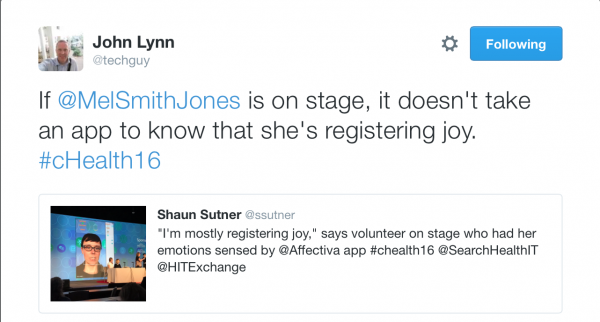I have lots of fun times at the Connected Health Symposium, but this year was extra special. Part of the reason was because when the moderator of “Emotion Sensing – The Next Big Trend?” asked “Would anyone like to volunteer to have their emotions sensed and documented for all to see?” my hand shot up like a rocket, and, much to my delight, I was selected. Allow me to elaborate.
Over the past two years, creating a device that captures the data that our bodies radiate daily has been a thriving trend. On the consumer side we see this most readily in the world of Apple Health and wearables we all know and (sometimes) love, like FitBit. Stay tuned early next year when a device called Priya should enter the scene, which, among other things, will alert a woman and her partner when her body’s data signifies the conditions are right to conceive a child. This year is the first I’ve seen biofeedback turn towards the world of behavioral health. I mentioned the glass brain as one such innovation that blew my mind, and within this session we discussed several more including the Sensoree device I blogged about two years back. However, the star of this post is an application called Affectiva that maps facial patterns in order to sense emotion. The results of my volunteer efforts provided a giant rendering of my face to all Connected Health Symposium attendees. Good thing I’m not shy.
“I mostly registering joy…”
A couple of things I noticed immediately when interacting with Affective. The first was that my joy measures were off the charts. Anger was not at all present. I also did not register nervousness. None of this is surprising to me. Anger isn’t an emotion I call on all too often, and I’m fortunate that I do not get nervous on stage. However, I also wondered if this could be because joy is a much easier emotion to sense given the technology. Nervousness can be portrayed in all sorts of ways. Some people experience nervous laughter, and that could then register as joy instead of nervousness. I imagine in some nervousness could present as open hostility. So, for the most part, I think that innovations like this are definitely moving the bar forward, but I’m much more interested in the use of other forms of biofeedback, such as EGG and temperature/sweat gland production as the world of emotion sensing devices proliferate.
For now I leave you with the reaction to my on stage proclaimation that “I mostly register joy…” brought to you by my friends (new and old) in the great land of healthcare social media. Hopefully it makes you register some joy as well.

